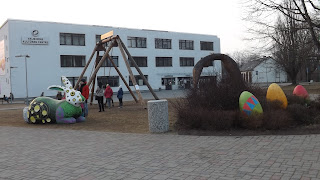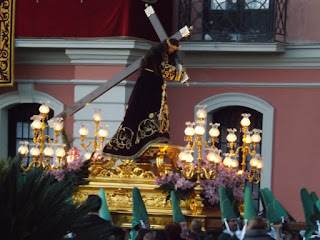"
Lieldienas" is the term that Latvia use for calling Easter, despite literally the name means "big day". So, but what Latvia has different in the Easter celebration against other countries? I would say almost nothing.
Yes.
Almost nothing.
Eggs and rabbits crow the streets just as in any other western country and celebrations and events about Easter crow the centres (I think I have been for too much in the theatre). Only that the latvian Easter has more flowers and happy welcoming to the spring, another note to add about how people here is very emotional about the seasons, heh.
Latvian Easter (Lieldienas). A somehow normal and dinky Easter.
But I say, the difference is minor. Specially comparing with my country. There is the real difference! I´ll tell you:
Spain and basically every country that was a spanish colony in the past, including Philippines and excluding Cuba, has a more religious background Easter. First of all, the "Easter" it´s called "
Holy Week" and the normal Easter is no other thing that a part of the full week of holidays in my country (althought currently the holidays day in your laboral agenda will be the same as in England, Latvia or France). This Holy Week is focused, as I was saying, in the religious background, specifically in the Catholic religion. And the Holy Week is the celebration of the death of Jesus Christ...
I mean...well...I explain, it starts with Palm Sunday (Carnival is another time) the week before, which conmemorates when Christ arrived to Jerusalem and then the REAL Holy Week starts on the Holy Thursday (the same day as in Latvia they have the Green Day) and from there until Sunday several events come along in most of the hispanic towns in the world. All these events focus in the last moments of Christ (Holy Thursday), the Passion of Christ and his death (Holy Friday) and finally, when Christ resurrects (Sunday´s Resurrection a.k.a. Easter Sunday).
And all these events are a series of parades called "procesiones"
"
Procesiones" started in Spain basically right when the Counter Reformation appeared and the Christianity had that "little" schism 400 years ago that unlaced the bloody 30 Years War and then, to assure that the Catholic Church wouldn´t lost fidels, the main supporter (Spain) made the idea to idolize Christ´s life, right the contrary the Reform professed.
And those are the "Procesiones": a parade of different and several platforms held by several persons (sometimes masked in an outfil called "Capuchino" other times not). These platforms always wear an iconic catholic figure, representing the religious events I aforementioned.
Most of the parades have a common denominator: the polychrome wood platform and individual religious figures in each of it. But depending of where you are you can find many other things: from people singing to one saint (such in Seville) to masked people who whipe themselves in their bare backs with a mop such in one of the loooovely villages of my region
or in Madrid from feminazi parades who doesn´t have any other thing to do that yelling and blame from all their disgraces to the Church and the men and making counter-parades.
Here some pictures of the Holy Week "Procesiones". And as you can see! they are not colorful eggs and happy rabbits, precisely:
Example of two of these platforms. They are called "pasos" and each one usually is 1 ton heavy to much more. These two "pasos" are part of the Holy Thursday "procesión", each one from a different city.
These are the so called "Capuchinos" (it´s spelled like the coffee, by the way). And, for clearing your mind from other well know outfits, they ARE NOT the KKK! ok? Capuchinos came much earlier.
Capuchinos come in different colour scheme depending of every town. Always two colours and from different brotherhoods, the religious groups who hold the "pasos" in the "procesiones" can be distinguised from the outfit colour.
In my village, for example, the capuchinos are purple and white except for the person who wears a natural size cross (the same size Jesus held in his passion) who is in black capuchino outfit and goes barefoot across the cobble streets. Purple is the most common color seen in the capuchinos´ outfit.
Even kids can join the brotherhood! it´s free for everyone!
"Los Picaos", one of the different ways to celebrate the Holy Week across the Catholic countries. Here´several men whip themselves during the whole tour. In some places such in Philippines there is people who gets crucified, for example, and some other ways to feel the last moments of Christ.
Well, as I said, it´s not a sweet and lovely egg with a rabbit holding it but I will tell you, one of the most curious things you ever find here is that, despite the big crow in the events, here is where spanish people will be more silent than in any other celebration. You will feel like if you were in Latvia just for that!






























































